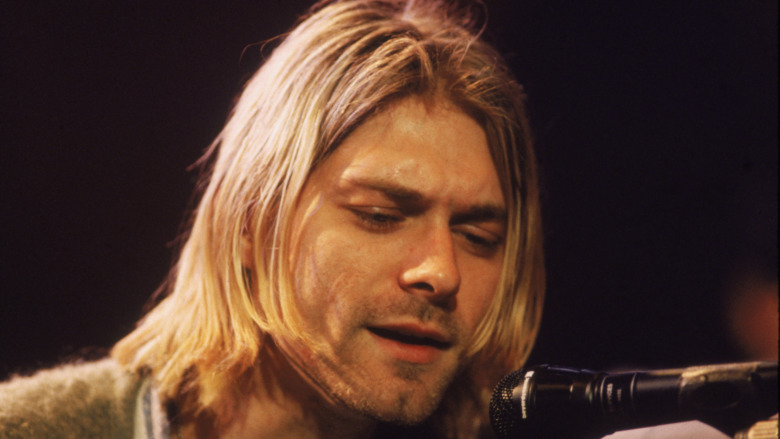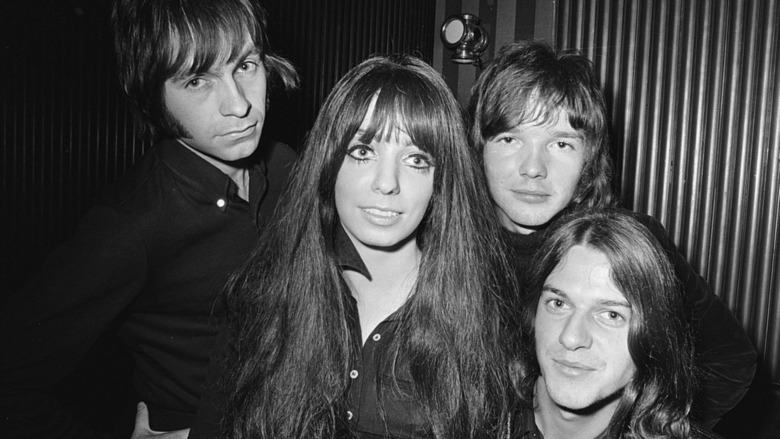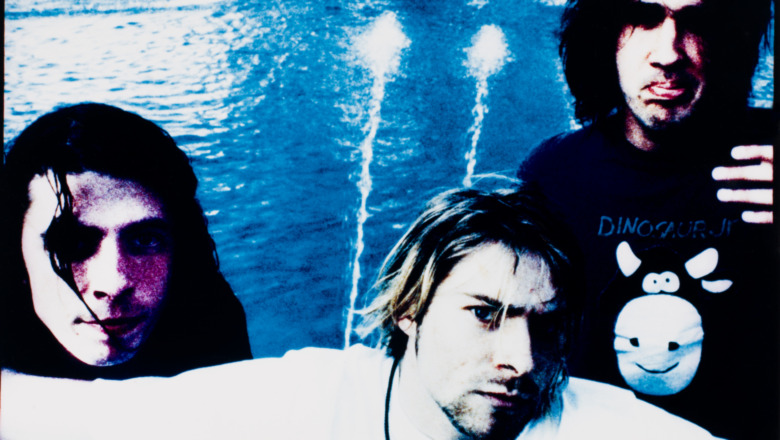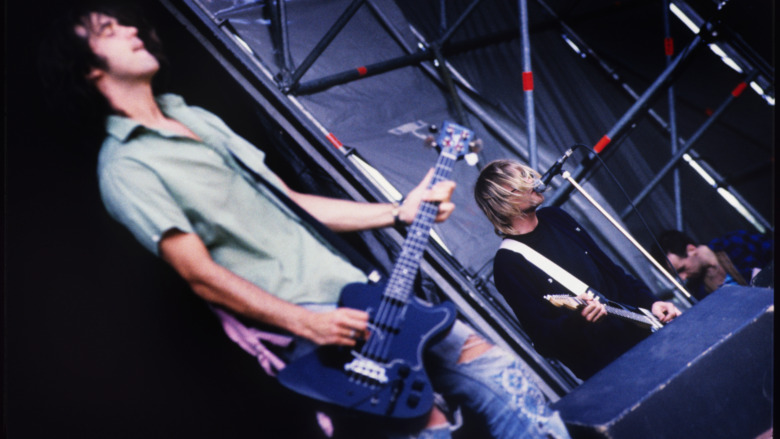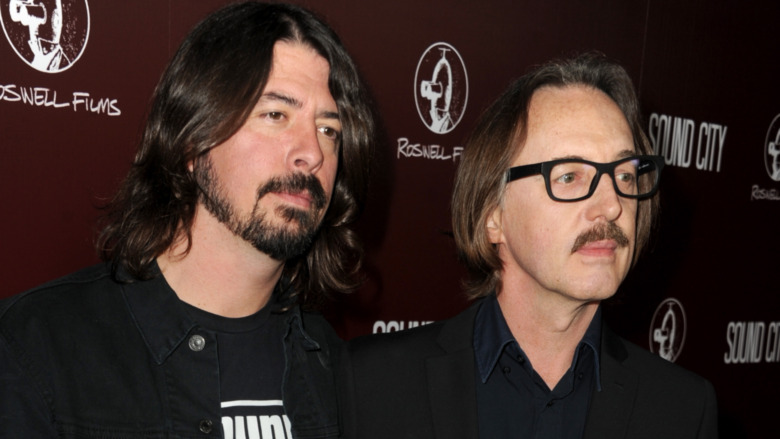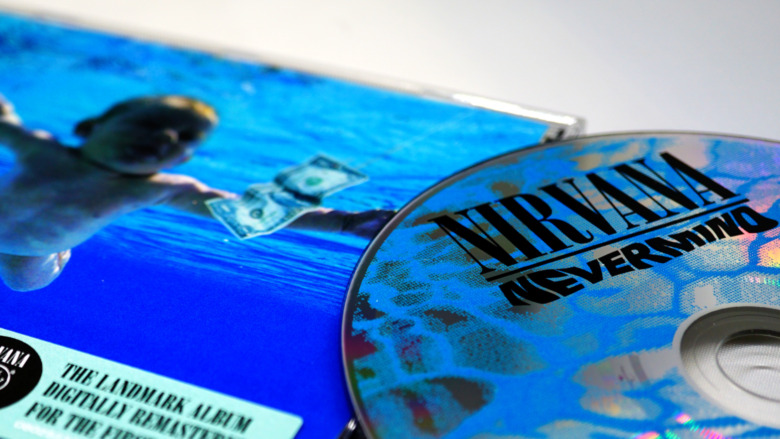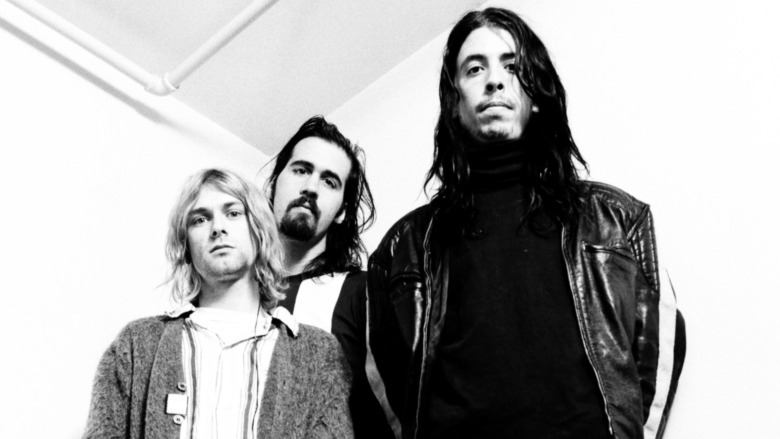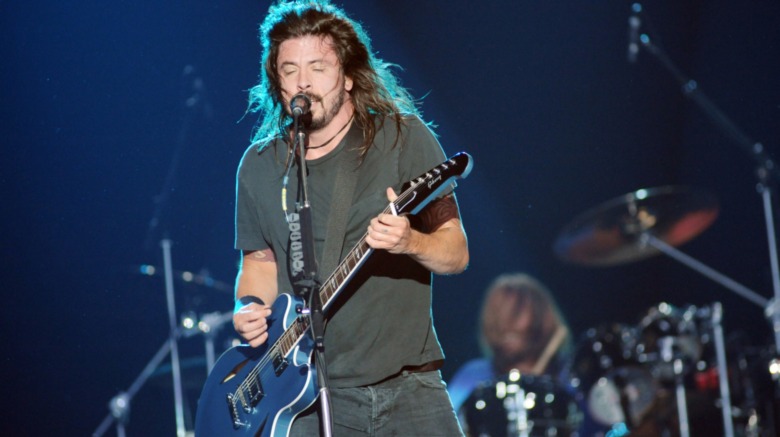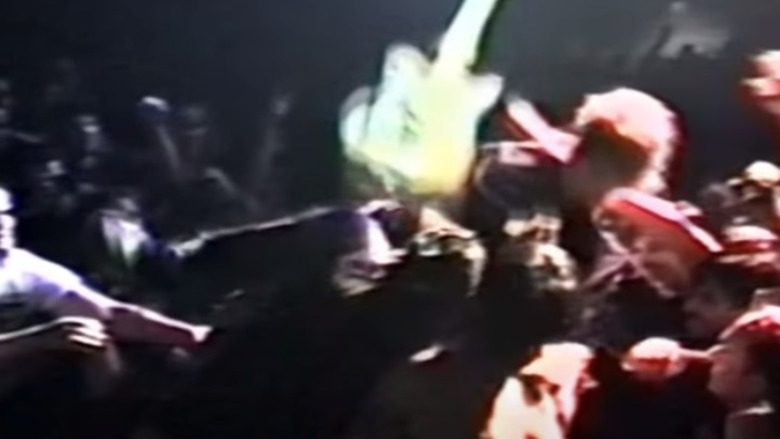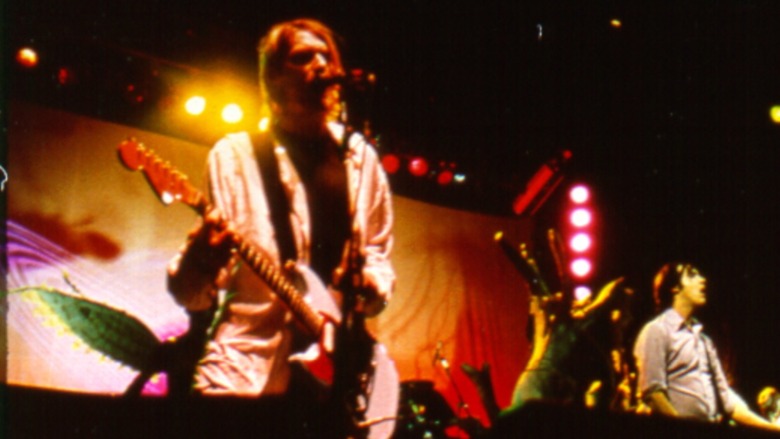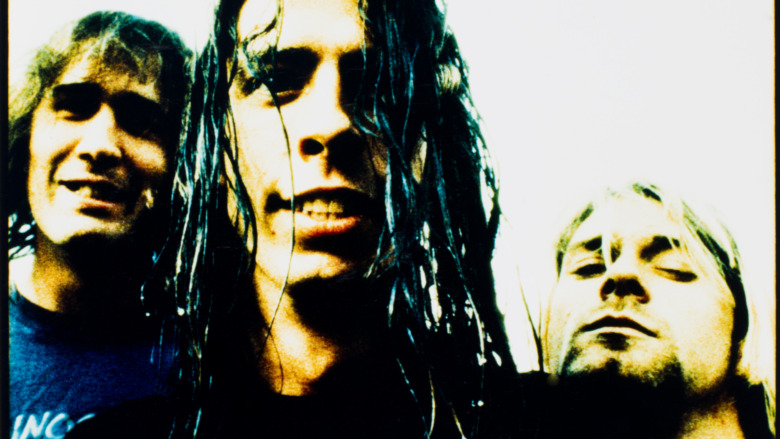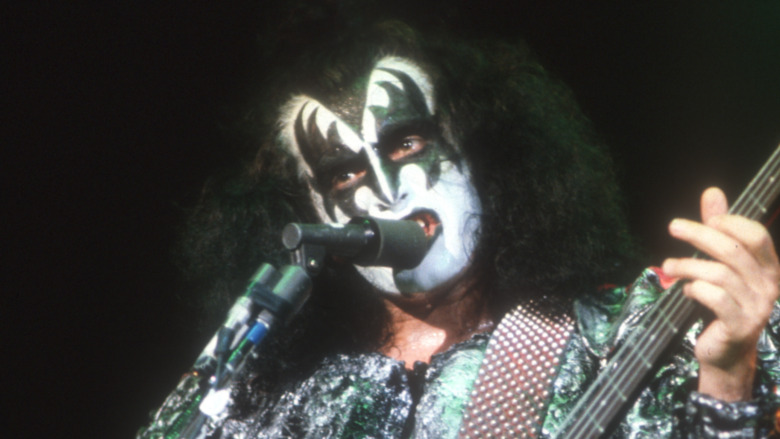The Untold Truth Of Nirvana
Whether you're a flannel-wearing, card-carrying Gen Xer or a millennial fostering a more recent Kurt Cobain and crew crush (or bromance), there's probably still a lot you may not know about Nirvana. A spate of quarter-century anniversaries have brought to light many fantastic new stories about everyone's favorite grunge band.
From setting couches on fire to playing football with the Chippendales and inciting riots, Nirvana participated in plenty of high jinks and antics. But they also rocked out to one of Cobain's favorite bands, ABBA (via Alternative Press), and fostered a longstanding musical obsession with Black Sabbath. Or as Dave Grohl put it on the "Jimmy Kimmel Show," "If Black Sabbath and ABBA had a love baby, it would be Nirvana."
Yet, long before the band coalesced as Nirvana, its core members, Cobain and Krist Novoselic, performed as The Sellouts, covering Creedence Clearwater Revival's music. The Sellouts would later split after Cobain physically attacked the bassist, Brown Towel. (Thanks to a misspelling on concert posters, his name appeared as Brown Cow, according to NME). Cobain and Novoselic later eschewed blues and country-rock for a grungier sound.
"Love Buzz" was a cover from a 1960s Dutch band
The band's first single, "Love Buzz" from "Bleach," teases at the raw energy and screaming power for which Nirvana would later gain acclaim. Yet, the hardcore single is an unlikely take on Robbie van Leeuwen's song for Shocking Blue, a Dutch psychedelic rock band. According to Westword, "Love Buzz's" Middle Eastern flair and 1960s stylings rendered it the perfect jam staple for Nirvana.
Nirvana's version relies on plenty of tricks that would reappear in later work. Although an obscure song, the band gave it new life, transforming it into something greater than the original. "Love Buzz" enjoyed a limited run of 1,000 as a part of the mythic Sub Pop label, and trying to buy a copy of the original today will cost you upwards of $3,000, according to Noise Crumbs.
Who was the band that inspired Nirvana's first cover? Shocking Blue formed in the Hague in 1967, channeling a strong Jefferson Airplane vibe. Although their version of "Love Buzz" doesn't have the brilliance of Nirvana's, Shocking Blue had a handful of hits during the 1960s and 1970s, as reported by Discogs. From Mint Royale to Bananarama and Jennifer Lopez, various groups have covered Shocking Blue. But Nirvana best personified the band's mid-century musical legacy while expanding upon it.
Kurt Cobain torched a club's couch to diffuse tension
Before 1991's Smells Like Teen Spirit launched Nirvana into the public eye, the band played many small venues where the intensity of their performances matched the ferocity of the backstage antics. According to promoter Mike Elko, as reported by the Pittsburgh Post-Gazette, Krist Novoselic's girlfriend allegedly tried to cheat the house out of money from t-shirt sales following the band's second performance at the Pittsburgh club, Graffiti – the mood blistered with tension.
The band outnumbered and not up for a physical altercation, Kurt Cobain took his frustration out on a backstage couch. After "sparking it with a pack of matches," accounts vary. Some say the furniture simmered, creating an unpleasant burning smell. Others claim it burst into flames, incinerating nearby objects.
No matter the version, the fire marshal soon appeared, and Nirvana's road manager got arrested. The club's owner, Tony DiNardo, chose not to press charges, permitting Nirvana to skyrocket to fame. Unfortunately, the couch, which would likely fetch a hefty sum at auction today, didn't survive the brush with Cobain.
Nirvana once played covers for an audience of 12
The release of Nirvana's debut album, "Bleach," on June 15, 1989, sowed a musical revolution. But it took a while for fans to catch on. The album failed to crack the Billboard charts and enjoyed little attention in June 1989. But it gained momentum among a core group of fans in Seattle, according to Loudwire.
After the release of "Bleach," the band headed out on tour to small clubs where they often entertained audiences that hadn't come for them. Everett True, author of "Nirvana: The Biography," recalls how at one such event in Portland, Oregon, the band discovered the club nearly empty. Sub Pop had asked Nirvana to fill in for Cat Butt, and apart from one loyal fan, the other 11 hadn't come for them. So, Kurt Cobain, Krist Novoselic, and Dave Grohl decided to have fun with the audience, covering songs on request. Hits played that night included Kiss's "Do You Love Me?"
While not heavily promoted by Sub Pop, "Bleach" would remain a consistent seller for the record label. With the release of 1991's "Nevermind," "Bleach" would finally earn the recognition it deserved, selling more than 1.7 million units despite its initial lukewarm reception. Although Nirvana rose to fame and signed to a major record label with "Nevermind," they always saw themselves as a part of the indie underground music scene, even helping to launch the careers of obscure artists, according to Billboard.
Nirvana remixed their mixing engineer's work on Nevermind
When Nirvana recorded "Bleach" in 1988 at Seattle's Reciprocal Recordings, they exhausted their total budget of $600, recording the entire album in three days. As the music producer and engineer, Jack Endino, told the Wall Street Journal, "There wasn't any screwing around. Contrary to some stories, I don't even remember seeing a beer in the studio." The result would be a stripped-down masterpiece whose underproduction has helped it stand the test of time.
But Nirvana recorded their next album, 1991's "Nevermind," under very different circumstances. Geffen Records brought the band to Los Angeles to record, extending them a vast budget compared to "Bleach." Nirvana hand-picked Butch Vig, who produced for Sub Pop, to engineer the album. As reported by Billboard, Vig chose a very straightforward mix, breeding discontent among record label execs who wanted more polish. Adding to the controversy, Nirvana didn't know how they wanted the tracks edited.
Kurt Cobain kept turning down the treble to sound more like Black Sabbath, which annoyed Vig. When the band decided to hire another sound engineer, Vig felt relieved. Out of more than a baker's dozen list of trending sound engineers, Andy Wallace stood out. He had worked with everyone from thrash metal band Slayer to Madonna. The mastering whiz remixed the tracks to the relief of label execs, giving it the high-gloss sheen they craved. Cobain would come to hate this radio-ready version, calling it "candya**" (via Slate).
The Nevermind baby wasn't the band's first choice
Like the mix of the album, the cover for "Nevermind" represented another artistic compromise. Kurt Cobain originally wanted an image of an underwater birth on the album cover. But studio execs found it too graphic for marketing. Instead, they settled on the underwater baby image (via CBC).
The addition of the dollar bill on a fishing line and hook came later. The band brainstormed countless ideas, including a raw steak, a burrito, and another CD, before the dangling dollar bill concept took hold. As for finding a photographer who could pull off the underwater baby photo? They poured through the equivalent of the photographer's yellow pages finding Kurt Weddle, who specialized in "submerged humans."
The shoot took place at the Rose Bowl Aquatics Center in Pasadena, California, says CNN. Out of 12 babies, an infant named Spencer Elden beat out the competition. Weddle shot 18 frames of Elden in a half-second before the infant got scooped from the water. The Eldens received $200 for the appearance on Nirvana's iconic cover. It would go on to become one of the most recognized album covers in music history, reaching more than 30 million homes (via MTV) and sparking a merchandise frenzy.
They got kicked out of their CD release party
Not surprisingly, the anti-establishment Nirvana clashed regularly with record labels and studio execs. Despite enjoying tremendous success with "Nevermind," they self-identified as the poster boys of anti-consumerism and youthful rebellion. And they weren't afraid to prove it. Nowhere would this spirit prove more obvious than the release party for their second album.
The glitzy gathering took place at the Re-Bar in Seattle, a steep departure from the low-key party Geffen Records had promised the band. Kurt Cobain, Krist Novoselic, and Dave Grohl found themselves deluged by canapes, cocktails, and kissy greetings. Although they initially fielded chitchat and signed autographs, things turned rowdy during the third replay of "Nevermind." Simultaneously, the party's charm wore thin for the three bandmates, and they reached the optimal level of intoxication for mayhem.
Several large bottles of Jack Daniels in, they started accosting the DJ booth demanding he play different songs. Soon, they ripped all of their band posters from the walls. But the craziness didn't stop there. Novoselic instigated a mass food fight by hurling a tamale at Cobain, who retaliated with guacamole. Appetizers and entrees soon flew, and the high-end suits of music industry elites got slathered. Before they knew it, all three band members stood curbside, covered in food, and laughing about the irony of getting tossed from their album release party (via Far Out Magazine).
Nirvana destroyed a drum kit to get comped a new one
Nothing says rock 'n' roll like destroying instruments on stage. Over the years, music's best and brightest have participated in this time-honored ritual. Some say The Who's Pete Townsend started the trend, smashing his guitar to bits during a show in 1964. Townsend drew inspiration from a performance artist named Robin Page who he had seen unceremoniously kick a guitar. The mad antics soon gripped the music world.
At the 1967 Monterey Rock Festival, Jimi Hendrix famously covered his guitar in lighter fluid, set it on fire, and then smashed the heck out of it during "Wild Thing." And Keith Moon of The Who took it next level, loading his drum kit with explosives. Later generations of bands would continue the tradition, from The Clash to Nine Inch Nails and Nirvana, according to Mel Magazine.
Although known for regularly destroying equipment onstage, one event stands out in Krist Novoselic's and Dave Grohl's memory. In a 2014 interview for "The Tonight Show With Jimmy Fallon," Grohl explained how Kurt Cobain spent the "Nevermind" tour slowly destroying his drum kit by poking holes in it with his guitar. With each new concert (and hole), the drums sounded worse. Grohl asked their agent for a replacement set but kept getting put off. Finally, Grohl begged Cobain and Novoselic to help him smash the drums to smithereens in Chicago, forcing the tour manager to purchase a new set (via Chicagoist).
Nirvana started a riot at St. Louis' Mississippi Nights
On January 19, 2007, Mississippi Nights, a veritable St. Louis music institution, closed its doors for the last time, bringing 14 years of wild and memorable shows to an end. Mississippi Nights proved more than a nightclub, attracting some of the most popular bands of the 1990s and 2000s. Headliners included the Police, Cheap Trick, the Red Hot Chili Peppers, Jane's Addiction, Soul Asylum, the Meat Puppets, and Nirvana.
But perhaps the most memorable gig remains the night Nirvana caused a riot at the club (via the St. Louis Post-Dispatch). It all started with tensions running high due to more fans than tickets. According to Live Nirvana, rowdy crowds devolved into "frenzied slam dancing" and airborne audience members. These wild antics led the venue's security to get increasingly rough.
Krist Novoselic begged audience members to "mellow out," and Kurt Cobain got in a beef with one bouncer who accidentally broke his distortion pedal by stepping on it. After locating a new one, the show continued. Still, fans refused to take it down a notch, eventually inspiring Cobain to invite them onstage, inadvertently sparking a stampede. Twenty minutes of chaos ensued before crowd members started leaving the stage, and the quasi-riot transformed into a performance again. When the Foo Fighters played St. Louis on July 20, 2008, Grohl reminisced about this event, claiming Cobain invited up the audience in retaliation for security's overly rough approach to crowd control that night.
A bouncer attacked Nirvana's taxi after an incident with a guitar
Many of Nirvana's misdeeds got caught on tape, including the night Kurt Cobain attacked stage hand, Van Blarcum, with his instrument. The event took place at the Trees in Deep Ellum, Texas, during the band's cover of Shocking Blue's "Love Buzz" (covered by Dallas News). Cobain launched into the pulsating crowd, whose members vied for memorabilia and positioning. Crowd surfing proved nothing new for Cobain, but Blarcum didn't appreciate the chaos it caused.
Far Out Magazine recalls the events of the evening. Attempting to return Cobain to the stage, Blarcum hit him in the face. It's not known whether this happened by accident or on purpose. Either way, it led Cobain to retaliate, smashing his guitar over the stage hand's head and drawing blood. Considering the guitar's weight and the metal stud at its butt, the fact Blarcum didn't get knocked out cold remains a miracle. Of course, this providence didn't help Cobain, who soon felt the sting of retaliation.
Blarcum pulled the singer from the stage, slamming him in the back of the head. Soon an unruly crowd of fans turned on the disgruntled employee, permitting Cobain to flee backstage. Dave Grohl and Krist Novoselic diffused the situation so the show could go on. After reassuring Cobain the offending stage hand split, the bashed-up singer returned to finish the show. But Blarcum reappeared after the concert, smashing the windows of the taxi in which the band made their getaway.
Nirvana played a game of football with the Chippendales
In September 2020, former rock promoter, David McLean, dished fascinating details about Nirvana's 1991 United Kingdom tour and backstage antics. According to Spin, Sonic Youth tapped Nirvana to play with them on their European festival tour, resulting in the classic rock documentary "1991: The Year Punk Broke," by Dave Markey.
Markey recalls those brief two weeks filled with plenty of drinking, hash smoking, and happy music-making. Nirvana stood on the precipice of fame, and Kurt Cobain smiled a lot, enjoying his last glimmers of pre-stardom freedom. As reported by Alternative Press, the band ended up in a hotel bar in Nottingham where the Chippendales, a group of male strippers, sat decompressing after a show. McLean doesn't recollect how it got started, but the band's manager challenged the Chippendales to a football game (aka, soccer) of five-a-side in the hotel parking lot.
Although no one recalls who won, McLean ended up hoodwinking the Chippendales' manager, forwarding Nirvana's drink tab to his room. During the tour, McLean also remembers Cobain hanging a disco ball in the band's tour bus and rocking out to ABBA's "Dancing Queen" as they blazed through the British countryside (via RadioX).
Krist Novoselic and Dave Grohl destroyed a hotel room
Hotels and rockstars don't mix. Just consider two of rock 'n roll's most notorious Keiths — Keith Moon and Keith Richards. Both got into plenty of trouble while traveling. Moon's capers included driving a Lincoln Continental naked into a hotel pool, resulting in a permanent ban from the Holiday Inn chain. And Richards threw a television out of his hotel window, according to The Points Guy.
But few musicians caused as much damage as Krist Novoselic and Dave Grohl after an interview with MTV's Kurt Loder in December of 1993 in St. Paul, Minnesota. As reported by MTV, after the questions ended, Kurt Cobain retired to his room, but Novoselic and Grohl refused to let the party end. Around 4 a.m., Loder remembers Novoselic taking a picture off the wall, using it as a battering ram in the room. With hotel security guards in hot pursuit, they hoofed it back to Loder's room where the interviewer hoped all would end peaceably.
Boy, was he wrong! Instead, Loder watched in shock and awe as the two musicians used chairs and a table to destroy the room. The result? $19,000 in damages. Loder still doesn't know who picked up the tab, but this event would go down in the annals of music history as one of the most expensive interviews of all time.
When not playing, Nirvana loved pranking
When not rehearsing, recording, or performing, Nirvana loved indulging in prank phone calls. Victims included Evan Dando of the Lemonheads, Eddie Vedder, and even KISS' Gene Simmons. How did the Simmons call come about? In 1994, KISS contacted Nirvana to participate in an upcoming KISS tribute album. The LP showcased many celebrated artists, including Lenny Kravitz, Anthrax, and even Garth Brooks.
Neck deep in the studio for In Utero, Nirvana didn't feel the KISS vibe. But nobody wanted to break the bad news to Simmons. After all, who would want to disappoint one of rock's greatest acts of all time? So, they decided to do the only responsible thing and prank call him instead. They enlisted the services of In Utero's producer, Steve Albini, for the dirty work. With a caveat, of course. Albini had to impersonate Kurt Cobain (via Alternative Press).
Reflecting on the chat he had with Simmons, Albini remembers bumbling through a lame excuse. The act worked, permitting Nirvana to escape the KISS tribute record tactfully. One can only imagine Cobain, Novoselic, and Grohl stifling their laughter as Albini wiggled his way out of the album invitation. As Albini observed during the "whatever, nevermind" podcast, "They were very fun-loving people. I enjoyed that session. They were fun to hang around with."
